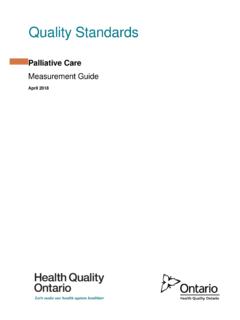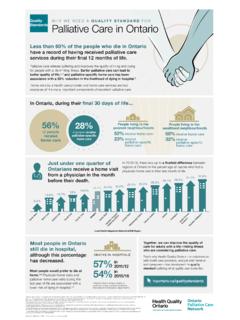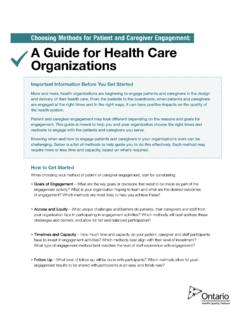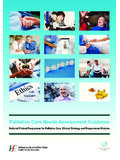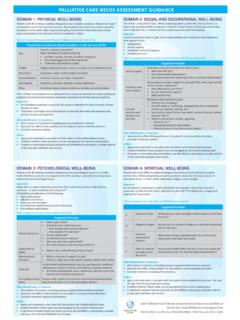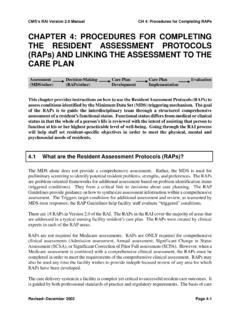Transcription of Palliative Care: Care for Adults With a Progressive, …
1 Palliative care care for Adults With a Progressive, Life-Limiting IllnessSummaryThis quality standard addresses Palliative care for people who are living with a serious, life-limiting illness, and for their family and caregivers. The goal of Palliative care is to relieve pain and suffering, and to improve a person s quality of life. This quality standard focuses on care for people in all settings, including home and community, hospice, hospital, and long-term care . Table of ContentsAbout Quality Standards 1 How to Use Quality Standards 1 About This Quality Standard 2 Scope of This Quality Standard 2 Terminology Used in This Quality Standard 2 Why This Quality Standard Is Needed 3 Principles Underpinning This Quality Standard 4 How Success Can Be Measured 4 Quality Statements in Brief 6 Quality Statement 1: Identification and Assessment of Needs 8 Quality Statement 2: Timely Access to Palliative care Support 12 Quality Statement 3: Advance care Planning Substitute Decision-Maker 15 Quality Statement 4: Goals of care Discussions and Consent 20 Quality Statement 5: Individualized, Person-Centred care Plan 25 Quality Statement 6: Management of Pain and Other Symptoms 28 Quality Statement 7: Psychosocial Aspects of care 31 Quality Statement 8.
2 Education for Patients, Substitute Decision-Makers, Families, and Caregivers 35 Quality Statement 9: Caregiver Support 38 Quality Statement 10: Transitions in care 41 TABLE OF CONTENTS CONTINUEDQ uality Statement 11: Setting of care and Place of Death 44 Quality Statement 12: Interdisciplinary Team-Based care 48 Quality Statement 13: Education for Health care Providers and Volunteers 51 Acknowledgements 54 References 56 About Health Quality Ontario 60 About the Ontario Palliative care Network 61 Palliative care care for Adults With a Progressive, Life-Limiting Illness | 1 About Quality StandardsHealth Quality Ontario, in collaboration with clinical experts, patients, residents, and caregivers across the province, is developing quality standards for Ontario. Health Quality Ontario has worked in partnership with the Ontario Palliative care Network to develop this quality standard.
3 Quality standards are concise sets of statements that will: Help patients, residents, families, and caregivers know what to ask for in their care Help health care professionals know what care they should be offering, based on evidence and expert consensus Help health care organizations measure, assess, and improve their performance in caring for patients The statements in this quality standard do not override the responsibility of health care professionals to make decisions with patients, after considering each patient s unique to Use Quality StandardsQuality standards inform clinicians and organizations about what high-quality health care looks like for aspects of care that have been deemed a priority for quality improvement in the province. They are based on the best available also include indicators to help clinicians and organizations assess the quality of care they are delivering, and to identify gaps and areas for improvement.
4 These indicators measure processes, structures, and outcomes. In addition, tools and resources to support clinicians and organizations in their quality improvement efforts accompany each quality more information on how to use quality standards, contact | Palliative care care for Adults With a Progressive, Life-Limiting IllnessScope of This Quality StandardThis quality standard addresses care for Adults with a progressive, life-limiting illness, and for their family and caregivers. It focuses on Palliative care in all health settings, for all health disciplines, and in all health sectors. It includes information about general Palliative care that applies to all health conditions. Palliative care can benefit individuals and their caregivers as early as at the time of diagnosis of a progressive, life-limiting illness through the end of life and bereavement.
5 Condition-specific Palliative care may be addressed in other quality standards. Although this quality standard includes information that could apply to infants, children, and youth, a separate Palliative care quality standard is being considered for these document does not address medical assistance in dying. People who choose medical assistance in dying should receive high-quality Palliative care . Health care professionals are expected to manage all requests for medical assistance in dying in accordance with the expectations set out by their regulatory colleges. Health care professionals should refer to their regulatory colleges for more information and guidance on medical assistance in dying. Terminology Used in This Quality StandardIn this quality standard, health care professionals refers to regulated professionals, such as registered nurses, nurse practitioners, pharmacists, physicians, physiotherapists, psychologists, occupational therapists, social workers, and speech-language pathologists.
6 We use the term health care providers when we are also including people in unregulated professions, such as personal support workers, behavioural support workers, and administrative staff. We use the term interdisciplinary health care team when we refer to all individuals who are involved in providing care (including health care professionals and health care providers).About This Quality StandardPalliative care care for Adults With a Progressive, Life-Limiting Illness | 3 Why This Quality Standard Is NeededPalliative care (also known as hospice Palliative care ) refers to the relief of suffering and improvement of the quality of living and dying, using a holistic Palliative care addresses people s physical, psychological, social, spiritual, and practical needs, as well as their associated expectations, hopes, and fears. It helps people with a progressive, life-limiting illness and their family prepare for and manage end-of-life choices, the process of dying, and coping with loss and ,2 Palliative care does not focus just on end-of-life care ; a Palliative approach to care can begin upon the diagnosis of a life-limiting illness.
7 People can receive Palliative care while actively receiving treatment for their disease. Despite the clear benefits of Palliative care , there are many gaps in its delivery in Ontario, including access to Palliative care services. Of the about 94,500 people who died in Ontario between April 2015 and March 2016, about 56,000 (59%) received Palliative care services on at least one occasion in their last 12 months of Among people who died in Ontario in 2015/2016, about a quarter ( ) received physician home visits, and about one-third ( ) received Palliative -specific home care in their last month of Receiving Palliative home care has been associated with a 50% reduction in the likelihood of dying in ,4,5 Furthermore, more than half ( ) of people who died in Ontario had unplanned visits to the emergency department in their last month of Whether or not people are able to die in the place they choose also reveals gaps in the provision of Palliative care across the province.
8 In surveys of patients and caregivers, most say they would prefer to die at ,6 And yet, of the about 94,500 people who died in 2015/2016, died in Increased access to Palliative -specific home care and home visits from physicians could reduce the number of people who die in Equity is also an issue in the delivery of Palliative care . In 2015/2016, patients living in poorer neighbourhoods were less likely to receive Palliative home care services in their last month of life ( ) than patients in the richest neighbourhoods ( ).2 Income is one equity issue, but there is also a need for culturally sensitive services to meet the diverse needs of all Ontarians. This includes access to culturally appropriate and safe Palliative care across urban, rural, and remote communities, and includes various cultural, faith, and linguistic groups, and vulnerable 13 quality statements that make up this quality standard are based on the best available evidence and guided by expert consensus from health care providers and people with lived experience.
9 The statements provide guidance for areas identified by the Ontario Palliative care Network and Health Quality Ontario s Palliative care Quality Standard Working Group as having high potential for improvement in the way Palliative care is currently provided. Each statement has accompanying indicators to help health care providers and organizations measure the quality of the care they provide, and includes details on how successful delivery can improve Palliative care and quality of life for people living with a progressive, life-limiting illness, their family, their caregivers, health care providers, and health services at THIS QUALITY STANDARD CONTINUED 4 | Palliative care care for Adults With a Progressive, Life-Limiting IllnessABOUT THIS QUALITY STANDARD CONTINUED Principles Underpinning This Quality StandardThis quality standard is underpinned by the principles of respect, beneficence, autonomy, justice, and equity.
10 People should receive Palliative care services that are respectful of their rights and dignity. Person-centred care compassionate care that respects people s wishes, beliefs, and values by promoting autonomy, dignity, and inclusion in shared decision-making as appropriate is fundamental to an ethics-based Palliative approach to high-quality health system is one that provides good access, experience, and outcomes for everyone in Ontario, no matter where they live, what they have, or who they are. People who have a progressive, life-limiting illness should be offered services that are respectful of their gender, sexual orientation, socioeconomic status, housing, age, background (including self-identified cultural, linguistic, ethnic, and religious backgrounds), and disability. Equitable access in the health system also includes access to culturally safe care .
